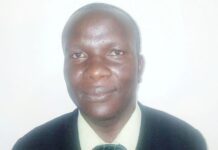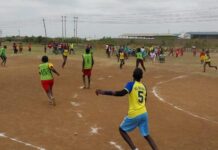
Elizabeth Merab, 28, has battled Sickle Cell Disease for 18 years now.
She gives us a clearer perspective of what it is to be born with and live with SCD.
Merab was born and bred in Nyeri County, which is not a malaria dominated county (SCD is a body response mechanism against malaria, dominant in regions prone to malaria such as Western Kenya, Coastal region and some parts of Northern Kenya).
Throughout her infancy, she had health complications and was usually taken for medication against an unknown disease.
While undergoing a myriad of tests, she was given antimalarial drugs and hydrants, since the doctors suspected a malarial infection.
The issue became clear when she turned 10.
“I was diagnosed at the age of ten. That’s when my parents knew what the doctor told them, that I had Sickle Cell Disease,” Merab recalls.
“This was after so many painful tests that were done,” she adds.
She jokingly describes herself as very curious, “the cat who was going to be killed out of curiosity.”
It is this curiosity that drove her into knowing that she had SCD, even before the doctor or parents told her.
She was getting medical care in a mission hospital in Nyeri county.
“I had spent about 5 days in hospital with my mother. The doctor came and sat my parents in her office and as she was giving this news to them, I was behind the door on the other side and I just heard ‘Merab has Sickle Cell’,” Merab remembers.
As a kid, she went back to bed and when her parents came back, she asked her mother, “Mum, what is Sickle Cell?”
Her mother wondered where her daughter had heard the term from, but assured her that “we will deal with it, don’t worry.”
After 10 years of groping in the dark, they now knew what they were dealing with and had to shift their attention, to focus on managing the SCD.
When Merab talks of pain due to Sickle Cell, she talks of intense, pricking pain as that of getting constantly pierced or pricked by something on the whole or part of the body.
It is not the normal pain we are used to.
The concept, which is a wrong one, is that when you feel pain, your body has to simply get used to it and you don’t need to complain about it.
“My most recent visit to the hospital is a week ago. What took me to hospital was pain or what presented itself as pain in my right hand.
Being my dominant hand, I could not do anything with it. I could not stop this stabbing pain or lock it out of my mind. So I needed to do something about it, ” she explains.
Doctors determine the level of pain by using a scale of 0-10, where 0 is no pain and 10 is the worst, deepest pain one can ever feel.
Sometimes, she feels like her pain has exceeded the scientific scale of up-to 10.
“Sometimes I tell the doctor that my pain is 15 out of 10,” she says.
“It’s pain that makes you want to cry. It makes you forget that you’re an adult and you just want to roll on the floor and make it stop! Your focus shifts to that pain,” she continues.
The pain overrides the body, seemingly telling the patient “Hey, you have to address me and do it now, otherwise, I’m going nowhere!”
Scientifically, it is called Pain Crisis or Sickle Crisis.
Any extremes of stress, joy, anger, anxiety, cold, heat, high or low blood pressure, are all causes of Pain Crisis and must be avoided.
There’s a remedy for the pain, however.
“Hydroxyurea has been studied in people with SCD for over 30 years, including adults and children.
It has been found safe in all these age groups, preventing all the severe complications of SCD, including pain and the need for hospitalisation.
It also extends life in adults with sickle cell, benefiting more those who take it for many years continuously,” comments Dr. Monica Hulbert, a specialist at St. Louis Children’s Hospital, USA.
On being diagnosed with Sickle Cell at the age of 10, life in hospital officially began, with hospital becoming her second home.
By now, she had missed a lot of classes, with her mother having lost hours of work.
“In and out, probably on a monthly basis. I remember I did both my national exams in hospital,” Merab recalls.
At the age of 18, an age where she had to take care of most of her financial and health needs, she decided to go for a retest.
The test, known as Hemoglobin Electroforesis, would ascertain to her if she has a Sickle Cell Trait (is a carrier) or Sickle Cell Disease (is a patient).
The results would take seven days, which she describes as “seven days of anxiety”.
Part of her wanted them to be negative, as anybody else wants to get healed.
The other part of her needed to know the results, whether positive or negative, allowing her to decide on how she would approach life and soldier on.
“Seven days later the results came and they were positive- 94% positive. That just crushed me,” she recollects.
Through with her teenage, she graduated from Campus in 2014 and set off for work.
Merab is now a Health and Science journalist, working for the Nation Media Group (NMG) in Kenya.
She thrives in telling health stories by covering medical science (anything to do with medicine and medicinal trials) and health research stories, which uncover research on health, new advancements in health sectors, visions and breakthroughs in different spheres of health.
She could not allow any health report weigh her down.
She pushed it at the back of her mind and forged forward.
Not after so long, however, that the issue started becoming a thorn in the eye.
“It now made the crises very frequent. I started going to hospital very frequently, the pain intensity went up and my mental status wasn’t so stable,” explains Merab.
Not allowing this to define her either, she would go to hospital, have pain management drugs, get transfused (to add more red blood cells for better oxygen circulation) and go back to work.
She finds fulfilment in penning her stories, pointing out that, “I always want to wake up and tell a health story that will have a positive impact on the health system or on the patient’s life.”
Life was just normal from 2017 through to October 2020, though still under medication.
“In October 2020, just eight days to my birthday, I was diagnosed with Vascular Necrosis- a condition where cells or body tissues of the hip bones die due to a disease or insufficient blood supply.”
The news cut deep in her heart. She needed an immediate surgery to reintroduce oxygen into the bones.
A successful surgery would see her in a wheelchair for three months and make her use walking frames in an effort to relearn how to walk.
“The doctor said if I walked immediately after surgery, there was a high likelihood of I breaking all my bones on the legs, requiring another surgery,” she explains.
With time, this started impacting her financially, physically and psychologically.
Feted
She has however never allowed Sickle Cell to define her.
She believes that her life as a Health and Science journalist is what defines her.
She has since won many prizes and trophies for her outstanding journalistic work, flowering her life with success and achievements.
Merab advocates for SCD health policies for a standard health-care for SCD patients.
Luckily, though late on her side, in July 29, 2021, Kenya unveiled it’s own guidelines on the diagnosis, management and treatment of SCD.
“The emphasis must now move towards early detection and prevention of long-term complications of SCD.
Early diagnosis of the disease is important to initiate prompt management,” the new guidelines state.
As for Merab, which is the case with very few other SCD patients, “I have been able to successfully get that care in very few places; and those were private facilities, whose care is very expensive and accessible to very few people,” Merab laments.
So many kids die of SCD at the age of five and below.
Often, she has been confronted with a lot of stigma, especially from people and doctors who hold that pain is psychological and can simply be pushed aside, requiring no medication.
“My appeal to people is to be kind and empathetic to SCD patients. Appreciating that they’re not okay at a particular time goes a long way towards a mental sense of comfort,” she says.
“Employers should give them an equal platform based on merit and let them perform.”
To health workers, “When patients walk into that room, they did not leave their houses to go to hospital to chill! They went to seek medical care. My appeal would be: do your job and do it well.
Don’t be the source of stigma, insult and mental anguish for this patient,” Merab exhorts.
To everyone else she says, “Don’t be the source of stigma. Give support; physical or emotional. Just strive to be a better person.”
Editor’s Note:
This story is based on a video-recorded testimony of the subject as published by Emmanuel Yegon on his YouTube channel.
The Scholar Media Africa seeks to amplify the message and encourage people like Merab who could be living with the same condition and challenge policy makers to make life easier for such patients.
We salute Merab for being a Sickle Cell Disease warrior who ought to be emulated.
More information on signs, symptoms, diagnosis and treatment of Sickle Cell and related diseases is accessible online at Mayo Clinic.
Every year, at least 240,000 children in Africa are born with Sickle Cell Disease (SCD), of which an estimated 6,000 are in Kenya alone.
In the western region, it is estimated that 18% of children are born with a sickle cell trait and 4.5% will end up developing SCD.
In the lake region, about 17% children are carriers of the trait with 0.6% having SCD.
At the Coastal region, as per inpatient data, almost 1% of inpatient children have SCD and are almost 20 times likely to die compared to admissions of other deaths, data from allAfrica shows.
The famous Mayo Clinic defines Sickle Cell Disease as an inherited red blood cells disorder.
Normal red blood cells are flexible, round and move easily through blood vessels.
However, Sickle-celled red blood cells are shaped like sickles or the crescent moon (letter C).
These rigid, sticky cells can get stuck in small blood vessels, slowing or blocking blood flow and oxygen to parts of the body, causing pain.
Related article: HEALTH: Focusing on Sickle Cell disease










































